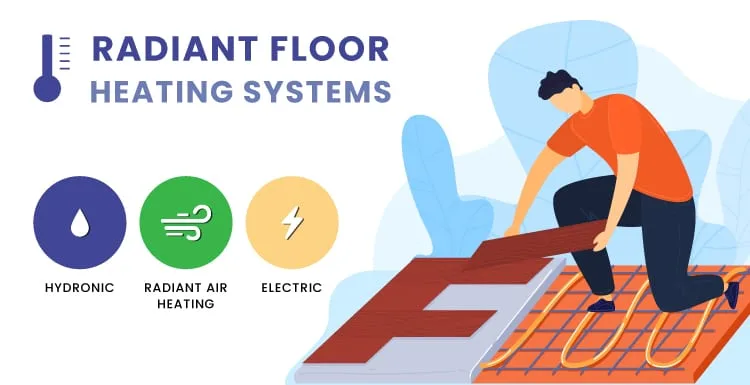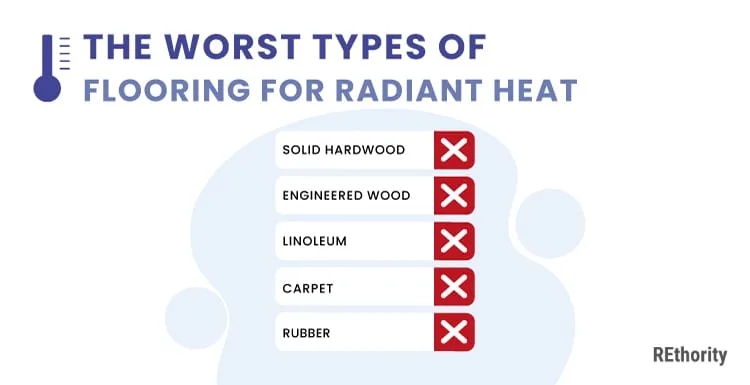Radiant floor heating is a unique but efficient way to heat your home.
If you’re considering installing a radiant floor heating system in your home or just wondering how it works, this is the guide for you.
Considering a Radiant Floor Heating System?

If you’ve ever stood in the sunshine and felt the warmth on your skin, you’re familiar with radiant heat. In fact, you’ve probably already experienced this sensation.
Ever opened your oven door and been greeted by a blast of hot air? Or, have you used a space heater, felt the heat coming from a lightbulb, cooked on a grill, or sat around a campfire on a chilly night?
If so, you’ve experienced radiant heat. As with the previous examples, radiant heat isn’t direct; you’re not actually contacting the heat source. You’re feeling the heat energy that radiates out from the heat source.
How It Works
This is an alternative to the more common forced-air heating systems. It allows heat to radiate up through the floor to heat the floor itself, the room’s furniture, and even the people or pets in the room.
Many homeowners consider it while building a house, and others think about using it for new additions to their homes.
You might be thinking about replacing your flooring and wondering if installing a radiant floor heating system is worth it. We’ll cover everything you need to know about these unique systems in this guide.
We’ll start with a general explanation of radiant floor heating, including how it works, the different types, and the pros and cons.
Then, we’ll look at the average cost to purchase and install these systems, the best flooring types to use with them, and how to decide if it’s right for you.
What Is Radiant Floor Heating?
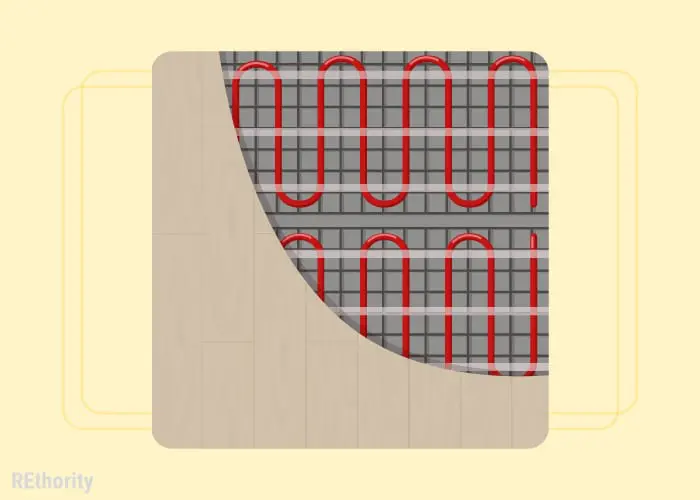
Radiant floor heating, also called hydronic or underfloor heating, works by generating heat from a fuel source (gas or electricity) and sending out the resulting heat energy directly up through the floor.
Every object in the room absorbs the heat energy coming up from the floor and radiates it out to other objects in the room, including the air.
This is much different from most heating systems that heat air and blow it out through vents to raise the home’s temperature.
With radiant floor heating, the air itself is evenly heated instead of being mixed with hot air (like in forced-air heating). Radiant floor systems heat the floor using special flexible tubes, which also heat everything in the room.
If you’ve ever wanted to step on a warm floor after getting out of bed on a cold morning or relax on a gently heated sofa, radiant floor heating is what you want.
Types of Radiant Floor Heating
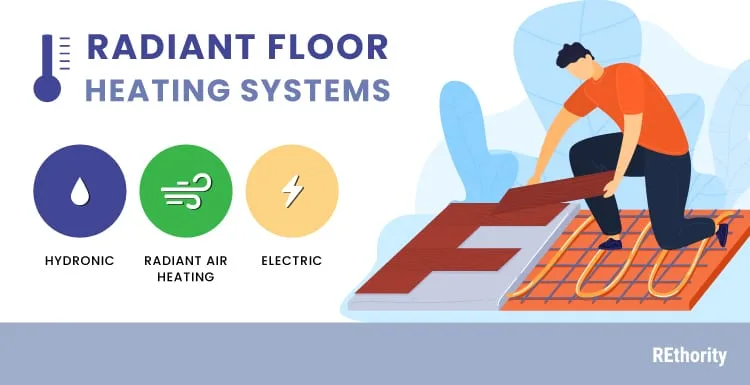
There are three types of radiant floor heating. If you’re thinking of installing a radiant floor heating system in your home, you’ll have to choose between these three types.
Hydronic Radiant Floor Heating
Hydronic radiant floor heating uses hot water as the heat-carrying medium. A water heater or boiler is used, along with pumps, to heat and recirculate water through tubes installed under the flooring.
Hydronic radiant floor heating systems are the most commonly used, and they are the most efficient.
Radiant Air Floor Heating
There are also radiant air floor heating systems that use air as the heat-carrying medium. It’s less efficient than hot water and electricity because the air loses heat quickly.
Air underfloor heating systems don’t need a water heater or boiler because they use small heating units embedded in the floors and the tubing that carries the warm air.
For homes and rooms with very little heating needs, radiant air floor heating could be an option. For most, it’s just not powerful enough.
Electric Radiant Floor Heating
Electric radiant floor heating systems are the third type. These rely on electrical mats being installed and embedded in the floor. The mats generate heat that radiates upward through the floor.
Electric radiant floor heating systems are more efficient than radiant air but less efficient than hydronic systems. They are also usually more expensive to operate, depending on the cost of electricity in your area.
These systems are best for small spaces. I’d know—I installed one below the tile in my master bathroom. In the Midwest, our winters get chilly, and there’s nothing nicer than stepping onto warm tile in the morning.
Radiant Floor Heating Installation Methods
There are two methods of installation for underfloor heating systems: wet and dry installations.
- Wet installation: A slab of concrete or similar substance is installed over a wooden subfloor
- Dry installation: Radiant floor tubing is installed between two layers of plywood or attached under the finished floor or subfloor
How Does Radiant Floor Heating Work?

It’s easier to understand how radiant floor heating works when you know all the components used in a radiant floor heating system and their roles. Let’s break down the parts and process them.
We’ll use the more common and efficient hydronic heating systems (with wet installation) as an example.
A hydronic radiant floor heating system consists of a heat source (water heater or boiler), a circulating pump, flexible PEX tubing, and a manifold.
In a wet installation, this is all installed on the subfloor and covered with a concrete, gypcrete, or dry-tamped mortar slab, then the actual flooring.
The water heater or boiler connected to the system heats the water for use, and the circulating pump moves the water around through the tubing.
The PEX tubing acts as the main artery for this system, carrying the hot water around under the floor. It’s installed in a back-and-forth manner, spanning across the room without any joints in the tubing.
It’s all one solid piece that winds all over the room. Special staples are used to hold it in place without crushing or damaging the tubing. Those PEX tubes are connected to the manifold where they begin and end.
The manifold ensures the water circulates evenly, with similar amounts moving through each part of the tubing. It also ventilates the system.
Once the water moves through the tubing, it returns to the water heater or boiler to be reheated. By this time, it’s lost a little heat and is about 10 degrees colder than when it was sent out.
The water is reheated to be recirculated and continues to heat the room from the floor up. This is a very small heat loss and is one reason radiant floor heating is so much more efficient than forced-air heating systems.
Benefits of Radiant Floor Heating
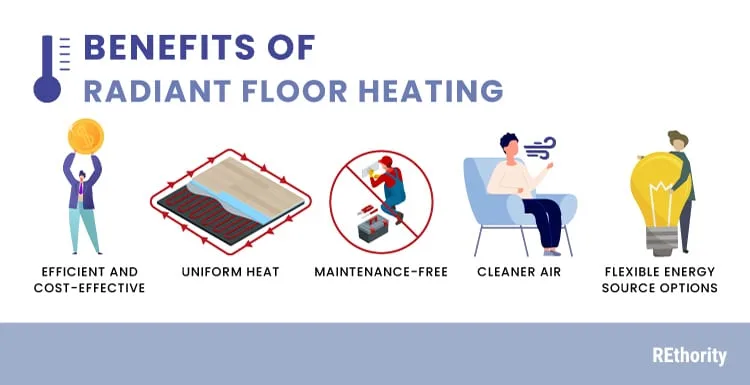
Many homeowners consider radiant floor heating because it has many benefits and advantages over other heating systems. Here are the most beneficial things about radiant floor heating.
1. Efficient and Cost-Effective
Radiant floor heating is about 25% more efficient and cost-effective to use than forced-air heating systems. The heat generated by these underfloor systems has nowhere to go but up and out into the floor, furniture, and people in the room.
That means that the heat losses are very low, unlike in other heat systems. Very little energy is used to make up for lost heat, and less energy is used overall.
This efficiency saves on energy costs as well. Less electricity or gas is used to generate heat, and better-retained heat results in lower energy bills and a more comfortable home.
2. Uniform Heat
Radiant floor heating results in extremely uniform heat without cold spots. Because all the heat moves up and out of the room from the floor, every solid object in its path is evenly heated.
In forced-air systems, the warmest areas are those near vents. Underfloor heating ensures the entire room feels warm and comfortable.
It has the added bonus of gently heating furniture, allowing people to feel comfortable even at a lower than normal temperature.
3. Maintenance-Free
If you’ve ever owned or rented a home with a forced-air heating system, you know that there’s quite a bit of maintenance involved. But radiant floor heating does not require much, if any, maintenance over the years.
It’s designed to be installed under the flooring, where it isn’t easy to access. So there are no filters to change or ducts to repair when you use underfloor heating. Once everything is installed, you’re good to go for up to 35 years.
4. Cleaner Air
If you or anyone in your household has allergies, a compromised immune system, or just wants the cleanest indoor air possible, radiant floor heating is the best choice.
There are no dirty filters, blowing allergen-laden air around, or physical disturbance of dust and debris from moving air through ducts. Radiant floor heating helps you keep the air inside your home cleaner and healthier.
5. Can Be Powered with Alternative Energy
If you’re living off the grid or just using alternative energy sources that cost less than electricity (like solar power, wood-fired boilers, etc.), radiant heating can easily fit into your lifestyle.
Several alternative energy sources can power these systems, and that’s a huge benefit for many homeowners.
Disadvantages of Radiant Floor Heating
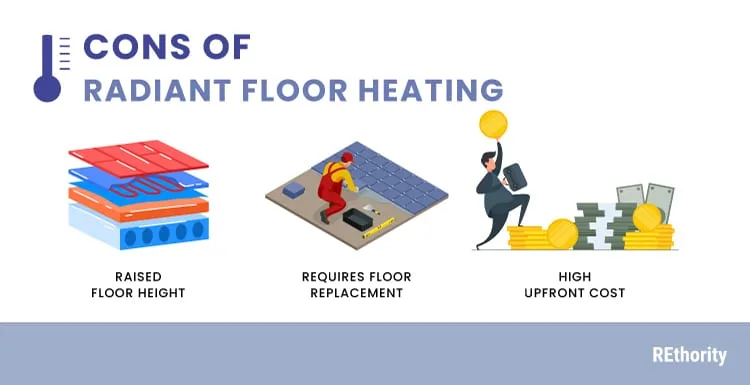
Radiant floor heating has many benefits, but there are some disadvantages to be aware of, too. Here’s what radiant floor heating leaves to be desired.
1. Raised Floor Height
Fitting a heating system, however thin, under your flooring means the height of the floor will be raised a bit to accommodate it. Electric radiant floor heating systems are generally thinner, while hydronic systems may be a little thicker.
Overall, the floor height is also raised slightly by any underlayment or installation membrane that is laid down. The floor height may be about ½” higher with a radiant floor heating system in place.
2. Requires Replacement Flooring
When you install radiant floor heating, no matter which type, the existing flooring will have to be removed and replaced. As you can imagine, this only adds to the overall cost.
Radiant floor heating is usually a better choice for new construction, so it can be installed without replacing the existing flooring.
3. Upfront Cost
Finally, one of the biggest disadvantages for homeowners who want to install radiant floor heating systems is the upfront cost. This type of heating system does provide long-term energy cost savings, but you’ll pay more upfront.
Electric radiant floor heating systems are cheaper to install than hydronic. See detailed information on the cost of radiant floor heating systems below.
Average Cost of Radiant Floor Heating

The cost of radiant floor heating is an important factor to consider. When you’re thinking about using a radiant floor heating system, you’ll want to consider the upfront cost to purchase and install. The costs differ between electric and hydronic systems.
Electric Floor Heating Cost
You can expect to pay around $10 to $20 per square foot to have electric floor heating systems installed.
Because the long-term cost of electricity can be prohibitively expensive, many homeowners choose to have electric floor heating installed in smaller rooms, like the bathroom.
Expect to pay about $1,760 for electric floor heating in an average bathroom. You may pay around $16,500 to have electric floor heating installed in a 1,500-square-foot house.
Installing an electric system can cost anywhere from $1,760 for a bathroom to around $16,500 for a 1,500-square-foot house. For a 2,500-square-foot house, the cost may be anywhere from $25,000 to $50,000.
Hydronic Floor Heating Cost
Hydronic floor heating systems are more expensive upfront than electric ones because of the additional equipment required. You’ll need a water heater or boiler, a pump, a manifold, and PEX tubing.
Consider the average cost of a water heater, ranging from $300 (small tank-style electric) to $3,000 (top-of-the line tankless). If you opt for a boiler instead, the cost rises.
Boilers run anywhere from $3,500 to $7,700. The rest of the system will bring that cost to about $14,000 for a 2,400-square-foot home. It can be as much as $48,000 if you opt to use a boiler.
The overall energy costs are much lower with hydronic systems, as the water better retains heat and runs less often than with electric systems.
Best Flooring Type for Radiant Floor Heating
When it comes to flooring types that are best for use in these underfloor heating systems, the most important thing to consider is how the material handles heat.
Like ceramic or porcelain tile, some flooring types are very good at retaining heat and helping it radiate out into the room.
Others, like carpet, prevent heat from efficiently moving upward and radiating out into the room. Choosing the right type of flooring for a radiant floor heating system is essential.
Here are the best types to consider and those you should avoid:
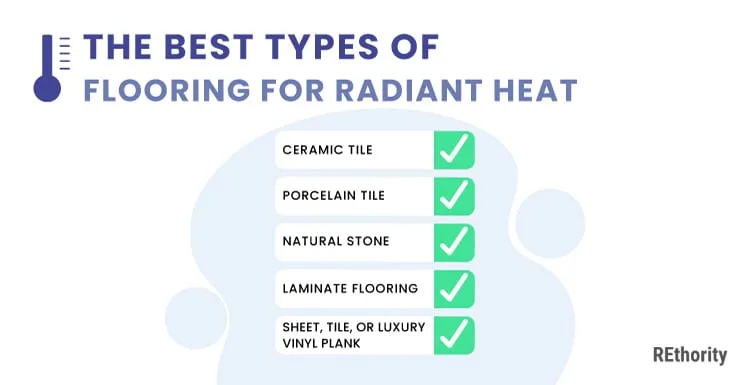
Best Types of Flooring for Radiant Heat Systems
- Ceramic tile
- Porcelain tile
- Natural stone
- Laminate flooring
- Sheet, tile, or luxury vinyl plank
Worst Types of Flooring for Radiant Heat Systems
- Solid hardwood
- Engineered wood
- Linoleum
- Carpet
- Rubber
While moisture and heat are not a good combination to have around solid or engineered wood, it can be just as bad for linoleum, carpet, and rubber flooring.
The heat directly under the floors can dry the adhesive and make it ineffective. It can discolor linoleum and cause rubber flooring to give off an unpleasant odor.
For these reasons, it’s best to stick with a type of flooring like ceramic or porcelain tile, natural stone, laminate, or vinyl flooring.
Is Radiant Floor Heating Right for You?

With all this information, you might still be wondering if radiant floor heating is the right choice for your home.
We’ll leave you with a few questions to consider:
Is your home a new construction?
New construction is the best scenario for installing radiant floor heating of any type. If you’re installing in your current home, you’ll have to remove your existing flooring, have the system installed, and install new flooring on top.
What’s your budget?
Remember the total cost of installing radiant floor heating – anywhere from about $1,750 for a bathroom (electric) and up to $48,000+ for an entire house (hydronic).
What power source will you use?
Electric radiant floor heating systems are cheaper than hydronic upfront, but they cost more in the long run due to the higher electricity cost. Hydronic systems are much more energy-efficient and cheaper to operate.
If you plan to use solar power or other alternative energy forms, you can easily accommodate that with either electric or hydronic systems.
Do household members have allergies or chronic illnesses?
Radiant floor heating is probably the right choice if any family members have allergies or chronic illnesses.
Dust, debris, and particulate matter are a problem with more common forced-air systems that blow these things around and stir them up in the air.
If you decide to have a radiant floor heating system installed, you’ll reap the benefits, like more uniform heating, cleaner air, cheaper utility bills, and no maintenance.
Just make sure the system is within your budget and makes sense for your household.
You might decide it’s worth it to install in a bathroom only (no more stepping on a cold tile floor after a shower) or throughout your entire home for even, comfortable heat.

